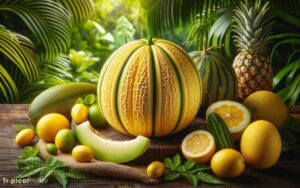Tropical Fruits That Can Grow in Pots: Explained!
Growing tropical fruits in pots is a viable and rewarding option for those with limited space or unsuitable ground soil.
Some of the best tropical fruits for container gardening include citrus varieties, dwarf bananas, pineapples, and avocados.
Tropical fruits are typically grown in warm climates, but with the right care, they can also flourish in pots, making them accessible for indoor or balcony gardens.
Container gardening allows control over the soil quality and watering, which is essential for tropical fruit plants that may not tolerate the colder ground soil of temperate regions.
Considerations for pot-grown tropical fruits include:
Enjoy a slice of the tropics at home by cultivating potted tropical fruit plants with the right care and conditions.
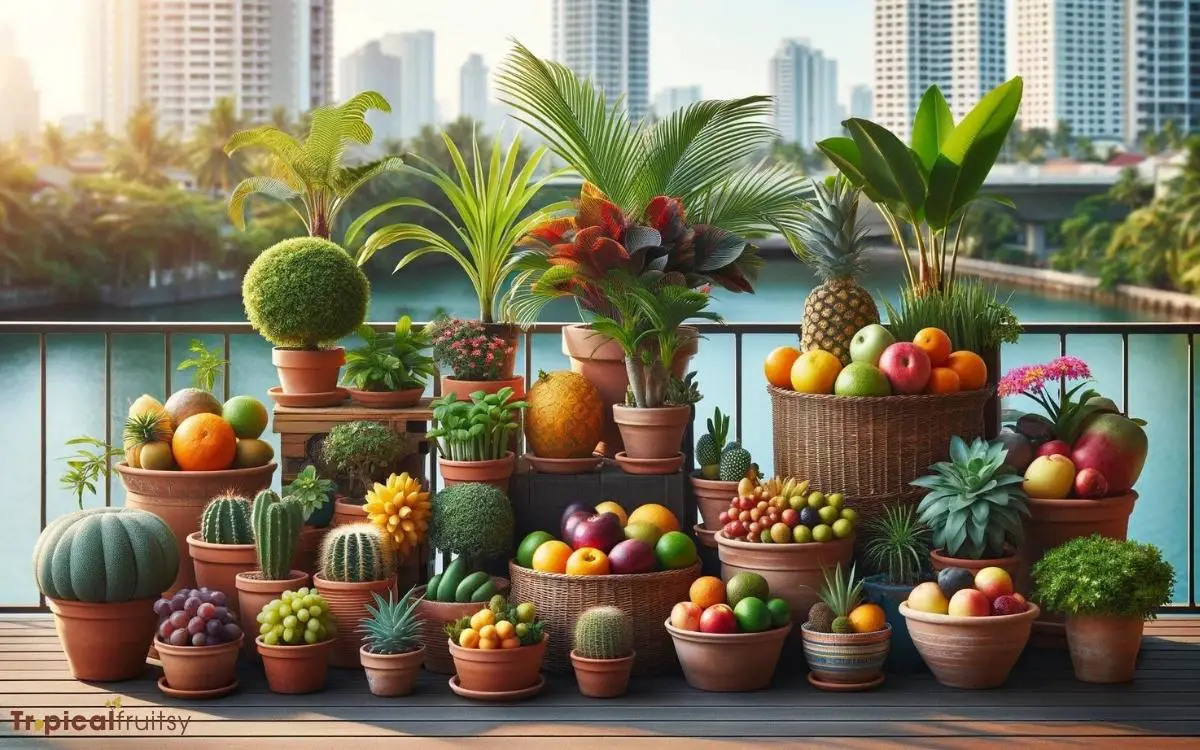
Key Takeaway
Tropical Fruit Container Gardening Guide
| Tropical Fruit | Container Size | Sunlight Needs | Watering Frequency | Special Care Instructions |
|---|---|---|---|---|
| Citrus Fruits | 18-24 inches | Full sun | Regular, consistent | Fertilize with citrus-specific nutrients |
| Dwarf Bananas | 15-20 inches | Full sun to partial shade | Consistent moisture | Protect from strong winds; may require staking |
| Pineapples | 12-18 inches | Full sun | Moderate; allow to dry out between watering | Avoid overwatering; requires warm conditions |
| Avocados | 24 inches or larger | Full sun to partial shade | Regular, allow soil to dry slightly between watering | Deep watering; sensitive to cold temperatures |
Selecting the Right Containers
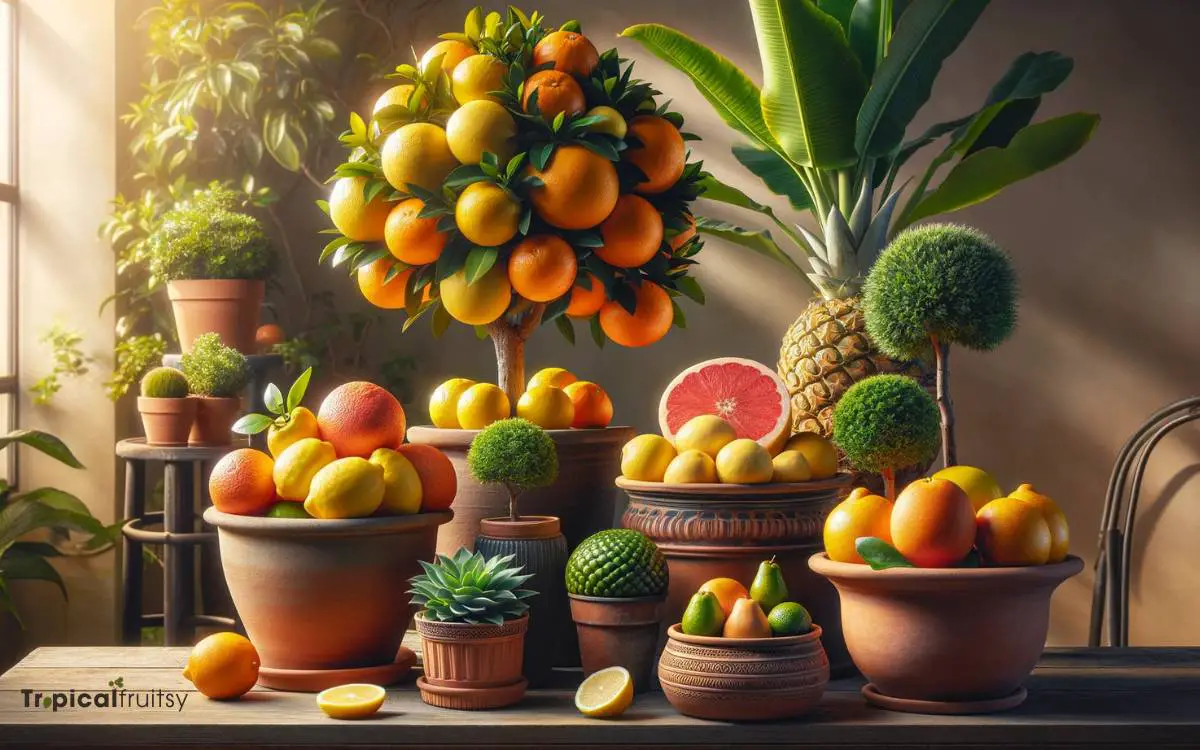
Selecting a container that accommodates a tropical fruit plant’s root system is crucial for its growth and fruit production.
The container must provide ample space for root expansion and development, ensuring that the plant can absorb necessary nutrients and water effectively.
A pot with a diameter and depth that are both at least twice the size of the initial root ball is recommended to facilitate appropriate root growth.
Additionally, the material of the container is significant; it should offer good drainage while retaining sufficient moisture. Ceramic or plastic pots generally provide a balance between these two needs.
Ensure the container has drainage holes to prevent waterlogging, which can lead to root rot and impair plant health.
Optimal container selection is a foundational step in cultivating healthy, fruit-bearing tropical plants in a controlled environment.
Citrus Fruits Varieties
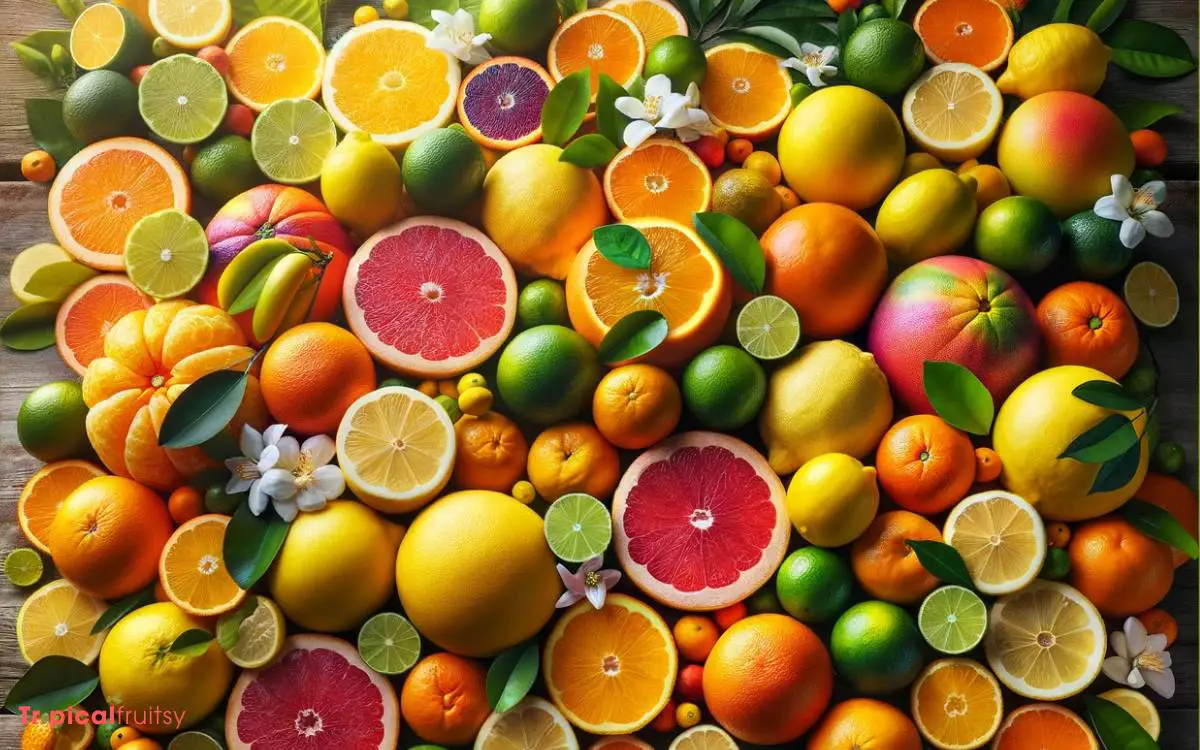
Citrus fruit varieties such as dwarf oranges, lemons, and limes are well-suited for pot cultivation, offering gardeners the opportunity to enjoy fresh, home-grown flavors even in limited spaces.
These dwarf varieties have been specifically bred to thrive in containers, making them ideal for balconies, patios, or indoor settings with adequate light.
When selecting citrus plants for pot cultivation, consider the following:
- Dwarf Meyer Lemon: Known for its sweeter, less acidic fruit and fragrant flowers.
- Dwarf Washington Navel Orange: Bears seedless, juicy oranges perfect for eating fresh.
- Dwarf Persian Lime: Produces seedless limes with a classic tart flavor.
- Dwarf Calamondin Orange: Offers ornamental appeal with small, tangy fruits used in marmalades.
- Kaffir Lime: Valued for its aromatic leaves, essential in many Southeast Asian dishes.
Selecting the right citrus variety and providing proper care will yield bountiful fruit even in a small space.
Dwarf Banana Plants
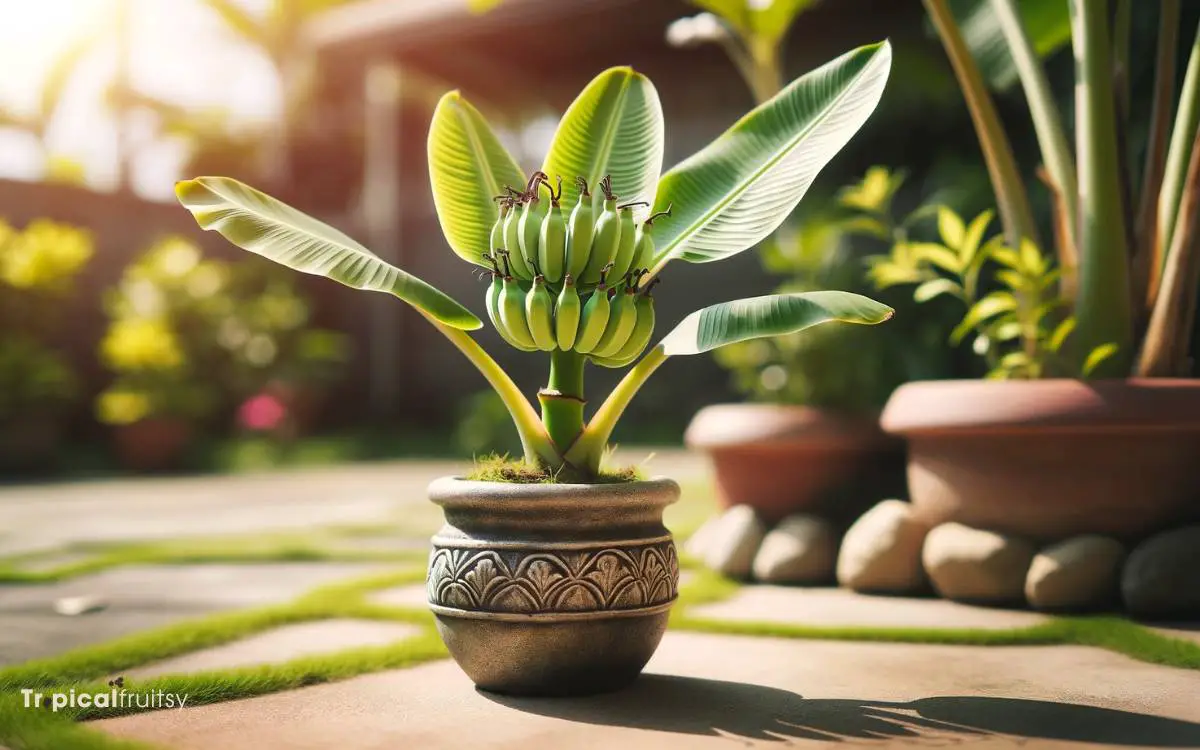
Transitioning from citrus varieties, dwarf banana plants offer an exotic addition to the container garden, producing edible fruit and lush foliage within a compact form.
These miniaturized versions of traditional banana trees thrive in large pots with adequate drainage and rich, well-aerated soil.
Dwarf banana plants require consistent warmth, making them ideal for indoor environments or temperate outdoor settings.
Sunlight is a crucial factor; they flourish in full to partial sun exposure. Regular watering is necessary to maintain moist soil, but overwatering can lead to root rot.
Fertilization should be done with a balanced, slow-release fertilizer to encourage robust growth. With attentive care, these potted banana plants can yield a sweet harvest.
As we consider the adaptability of tropical species to container life, we now turn our attention to growing pineapples in pots.
Growing Pineapples in Pots
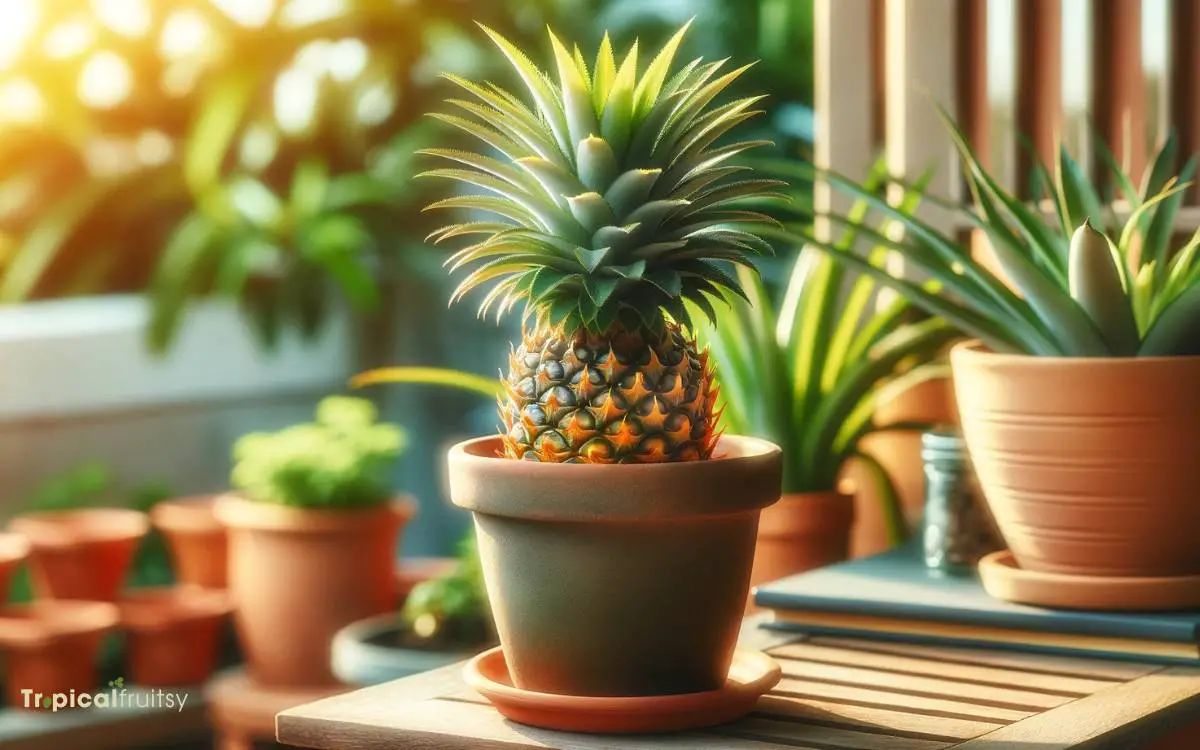
One can cultivate pineapples in pots by ensuring they have access to bright light, warmth, and well-draining soil, making this tropical delight a feasible option for container gardening.
The process requires attention to detail and a commitment to providing the right growing conditions.
To achieve a healthy pineapple plant, consider the following technical aspects:
- Pot Size: Choose a pot that is at least 12 inches in diameter and depth to accommodate the root system.
- Soil Composition: Use a light, airy potting mix with good drainage to prevent root rot.
- Watering Regimen: Maintain consistent moisture without waterlogging the plant; allow the top inch of soil to dry out between waterings.
- Fertilization: Apply a balanced, water-soluble fertilizer monthly during the growing season.
- Temperature Range: Keep the plant in temperatures between 65°F and 85°F for optimal growth.
Potted Avocado Trees
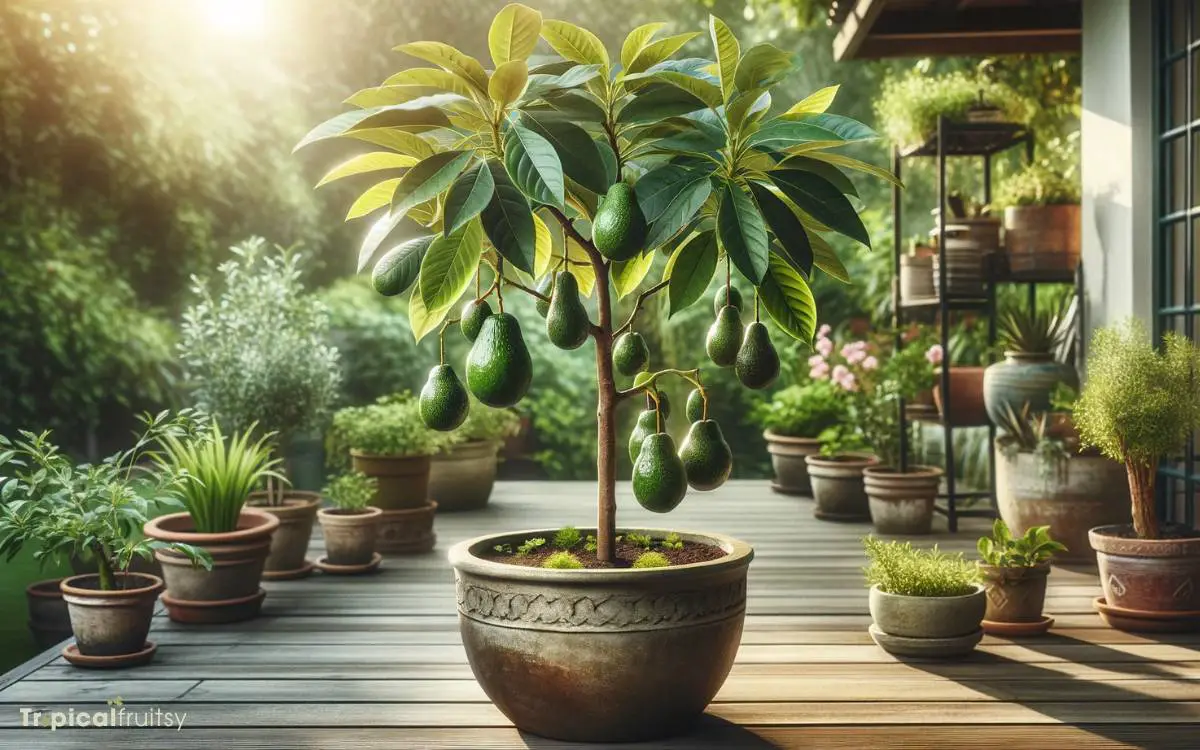
Cultivating avocado trees in containers requires attention to pot size, ensuring adequate room for root development and overall growth.
Proper care, including optimal watering practices and exposure to sufficient sunlight, is critical for the health and fruit production of potted avocados.
Regular pruning not only maintains a manageable tree size but also promotes a robust structure capable of supporting the weight of the fruit.
Suitable Pot Sizes
Avocado tree cultivation in containers requires careful consideration of pot size to ensure healthy growth and fruit production.
The pot size directly influences root development, water retention, and nutrient availability, all of which are critical to the vitality of potted avocado trees.
Here are key guidelines to follow:
- Minimum Pot Size: Start with a pot at least 15 inches in diameter and 15 inches deep.
- Growth Accommodation: Choose a pot that allows for the tree’s growth; repotting may be necessary as the tree matures.
- Drainage: Ensure the pot has adequate drainage holes to prevent root rot.
- Material: Opt for clay or ceramic pots for better moisture regulation.
- Stability: Select a heavy pot to counterbalance the top-heavy growth of avocado trees as they grow.
Avocado Tree Care
After selecting an appropriately sized container, maintaining a potted avocado tree requires diligent care, including regular watering, fertilization, and exposure to sufficient sunlight.
| Care Aspect | Guidelines |
|---|---|
| Watering | Keep soil consistently moist but not soggy. Allow the top inch of soil to dry out between waterings. |
| Fertilization | Apply a balanced, slow-release fertilizer every three months during the growing season. |
| Sunlight Exposure | Ensure the tree receives at least 6 hours of direct sunlight daily. |
Proper drainage is crucial to prevent root rot, so ensure the pot has holes at the bottom. Monitor for pests and diseases regularly.
Prune the tree to manage its shape and size, which also encourages healthy growth. A well-maintained avocado tree can thrive for years in a pot, providing both foliage and fruit.
Pruning Techniques
Regarding potted avocado trees, timely pruning is essential for maintaining tree health and optimizing fruit production.
Pruning not only helps in shaping the tree and controlling its size but also encourages the growth of new fruiting wood and improves air circulation through the branches.
Here are key pruning techniques for potted avocado trees:
- Selective Thinning: Remove overcrowded branches to enhance sunlight penetration and air movement.
- Topping Off: Limit the tree’s height to ensure it remains manageable and accessible.
- Deadwood Removal: Regularly cut away dead or diseased branches to prevent the spread of pathogens.
- Leaf Pruning: Moderately thin out leaves to increase light exposure to the inner canopy.
- Root Pruning: Occasionally trim the roots when repotting to encourage new growth and maintain a healthy root system.
Can Dragon Fruit be Grown in Pots as a Tropical Fruit?
Dragon fruit, also known as pitaya, is a tropical fruit that can indeed be grown in pots. With its vibrant colors and unique appearance, it adds a touch of exoticism to any indoor or outdoor space. A dragon fruit tropical fruit explanation reveals that this cactus-like plant thrives in warm climates and well-draining soil. By providing the right conditions and regular care, dragon fruit can flourish in container gardens, allowing fruit lovers to enjoy its delicious taste and numerous health benefits.
Caring for Potted Tropical Fruit
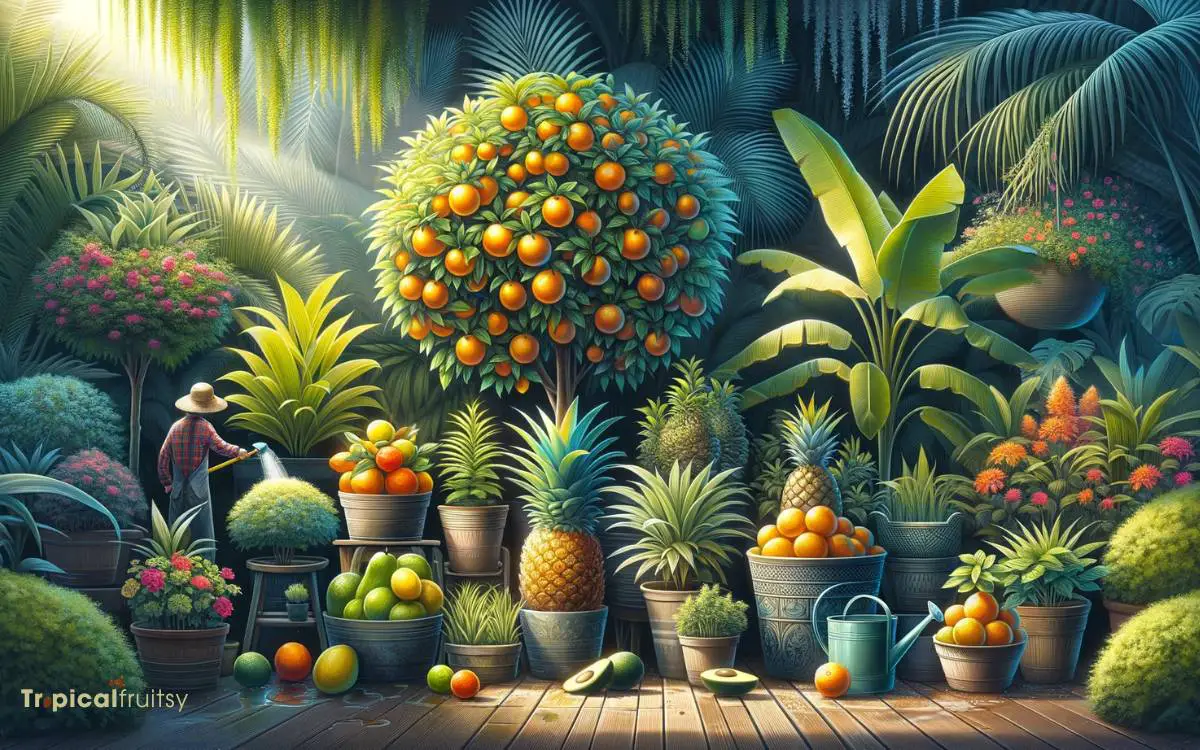
Proper care for potted tropical fruit plants involves selecting an optimal soil mix and mastering precise watering techniques.
Ensuring the right soil composition provides the necessary nutrients and drainage to support healthy growth.
Meanwhile, understanding the plant’s specific hydration requirements is critical to avoid over or under-watering, which can lead to root rot or dehydration.
Optimal Soil Mix
One must carefully select an appropriate soil mix to ensure the healthy growth of tropical fruits in pots, typically comprising a well-draining, nutrient-rich medium.
The ideal soil mix facilitates proper root development and aeration while retaining enough moisture to sustain the plant without waterlogging.
Here are key components to consider:
- Loamy Soil: Balances moisture retention and drainage.
- Perlite or Vermiculite: Enhances aeration and drainage.
- Organic Compost: Provides essential nutrients and improves soil structure.
- Coir or Peat Moss: Helps in water retention and root support.
- Balanced Fertilizer: Incorporate a slow-release fertilizer for sustained nutrient supply.
For best results, periodically assess and amend the soil mix to maintain optimal conditions for your tropical fruit plants.
Watering Techniques
Following the selection of an optimal soil mix, precise watering techniques are critical to the successful cultivation of tropical fruits in pots, as these plants are particularly sensitive to both over- and under-watering.
It is essential to establish a balanced watering schedule that accommodates the unique hydration needs of each tropical fruit species.
Monitor the soil moisture levels regularly; the top inch of soil should be dry to the touch before watering again.
Employ a deep-watering method to encourage robust root growth, ensuring water reaches the bottom of the pot. However, avoid waterlogging, which can lead to root rot.
Containers with adequate drainage holes are indispensable to prevent excess water retention. Adjust watering frequency according to seasonal changes in temperature and humidity, as well as plant life cycle stages.
Conclusion
Cultivating tropical fruits in containers is a viable method for enthusiasts to enjoy exotic flavors regardless of their geographic location.
Proper selection of containers, suitable dwarf varieties, and meticulous care can lead to successful harvests.
For instance, a study on urban gardening in temperate climates demonstrated that dwarf citrus trees, when given adequate light and care, can produce fruit comparable to their traditional counterparts, underscoring the potential of potted tropical fruit cultivation.



